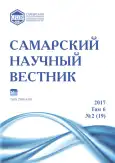Kashin princes in 60-80s of the XIV century
- Authors: Abukov S.N.1
-
Affiliations:
- Donetsk National University
- Issue: Vol 6, No 2 (2017)
- Pages: 121-125
- Section: 07.00.00 – Historical Sciences and Archaeology
- URL: https://journals.rcsi.science/2309-4370/article/view/21811
- DOI: https://doi.org/10.17816/snv201762206
- ID: 21811
Cite item
Full Text
Abstract
In the following paper the author researches the significance of Kashin as an important centre of the Tver Principality during the reign of Grand prince Vasily Mikhailovich and the confrontation between Moscow and Tver, Kashin unstable position of the princes, caused by the struggle of parties among the local ruling elite, caught between the two centers of power. As a result, the part of the elite continued to focus on Tver, while the other gave preference to Moscow. The latter position prevailed, which led to the refusal of the Prince of Kashin from the treaty with Mikhail and his involvement in the campaign against Tver in 1375. Special attention is paid to the growth of local separatism, the fate of the Kashin Principality under the treaty of 1375, securing its secession from the supreme power of Tver, as well as the short period of its formal independence and the circumstances of its return to Tver in 1382. The influence of the Kashin princes’ kinship ties, especially the marriage of Kashin prince Mikhail Vasilievich and the Moscow princess Vasilisa Semenovna, is also analyzed, the reasons, circumstances and significance of this marriage in the light of Moscow-Tver relations in the 60-80s of the XIV century in the general context of conjugal unions of the two leading principalities of North-Eastern Rus.
Full Text
##article.viewOnOriginalSite##About the authors
Sergey Navilievich Abukov
Donetsk National University
Author for correspondence.
Email: legusha@list.ru
candidate of historical sciences, senior lecturer of Historiography, Source Studies, Archeology and Methods of History Teaching Department
References
- Татищев В.Н. История Российская. В 7 томах. Т. V. М.-Л.: Наука, 1965. С. 104.
- Карамзин Н.М. История государства Российского. В 12 томах. Т. V. М.: Наука, 1992. 480 с.
- Соловьев С.М. История России с древнейших времен. В 18 книгах. Кн. II. М.: Мысль, 1988. 765 с.
- Борзаковский В. История Тверского княжества. СПб.: Издание книгопродавца И.Г. Мартынова, 1876. 434 с.
- Пресняков А.Е. Образование Великорусского государства. М.: Богородский Печатник, 1998. 496 с.
- Клюг Э. Княжество Тверское (1247-1485). Тверь: РИФ («Редакционно-издательская фирма») Лтд., 1994. 432 с.
- Экземплярский А.В. Великие и удельные князья Северной Руси в татарский период с 1238 по 1505 гг. Т. 2. СПб.: Типография Императорской Академии наук, 1891. 696 с.
- Baumgarten de N. Des Branches Regnantes de Rurikides du XIII-e au XVI-е siècle // Orientalia Christiana. Roma, 1934. Т. XXXV-1. P. 13, 53.
- Иноземцев А.Д. Удельные князья Кашинские. Эпизод из политической истории Руси XIV и XV столетий // ЧОИДР. М., 1874. № 4. 58 с.
- Полное собрание русских летописей. Рогожский летописец. Т. XV (Выпуск 1). М.: Наука, 1965.
- Акты социально-экономической истории Северо-Восточной Руси. Т. III. М., 1964. 688 с.
- Полное собрание русских летописей. Летописный сборник, именуемый Патриаршей или Никоновской летописью. Т. XI. М.: Языки русской культуры, 2000. 264 с.
- Полное собрание русских летописей. Московский летописный свод конца XV века / под ред. М.Н. Тихомирова. Т. 25. М.-Л.: Изд-во Академии наук СССР, 1949. 464 с.
- Духовные и договорные грамоты великих и удельных князей XIV-XVI вв. М.-Л.: Изд-во Академии наук СССР. 586 с.
- Борзаковский В.С. История Тверского княжества. СПб.: Издание книгопродавца И.Г. Мартынова, 1876. 434 с.
- Карамзин Н.М. История государства Российского. Т. 5. М., 1993. 560 с.
- Веселовский С.Б. Исследования по истории класса служилых землевладельцев. М.: Наука, 1969. 583 с.
- Полное собрание русских летописей. Тверской сборник. Т. XV. М.: Наука, 1965.
Supplementary files






